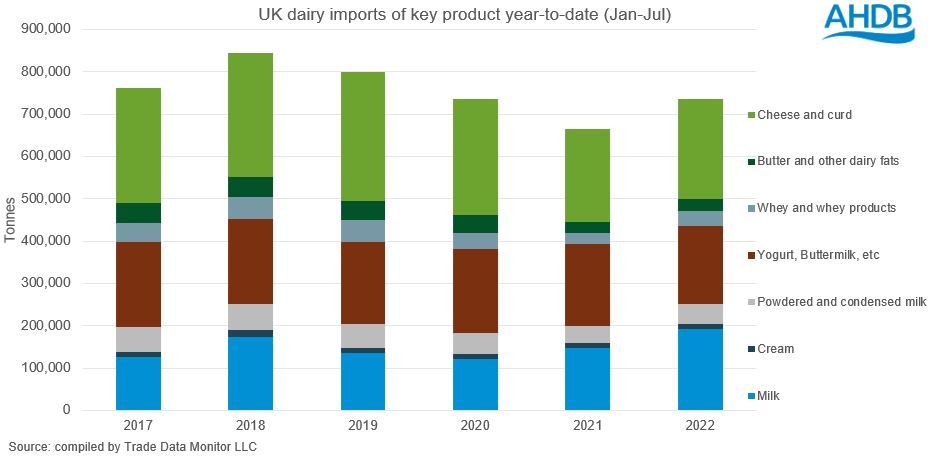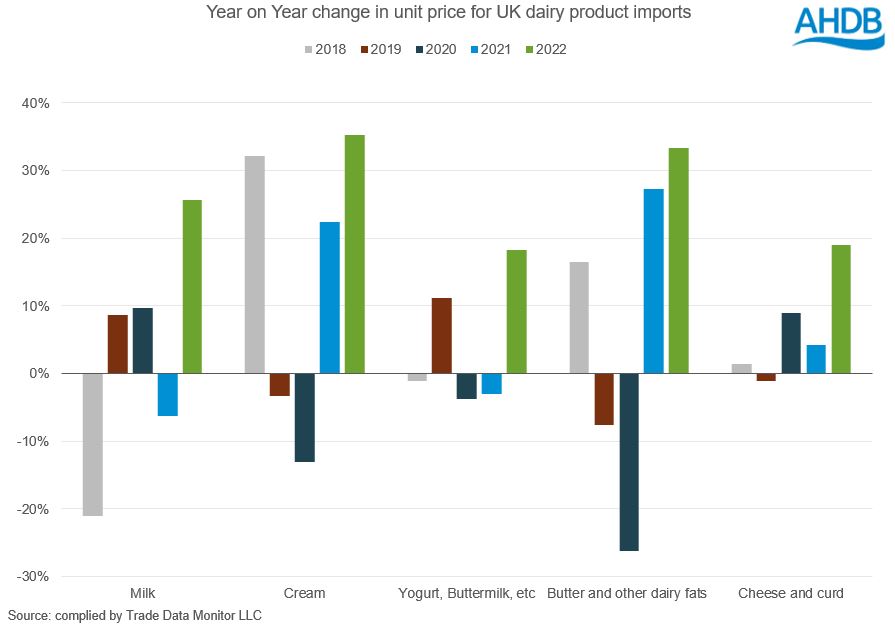UK dairy import volumes return to pre-Brexit levels
Thursday, 22 September 2022
So far this year (Jan-July), the UK has imported a total of 735,600 tonnes of dairy products, an increase of 11% year on year. Volumes of imported products were significantly lower in 2021 due to the impact of Brexit as well as continued disruption from the pandemic. Current import volumes are showing recovery, returning to 2020 levels as foodservice markets recover after the lifting of pandemic restrictions and businesses adapt to a new Brexit trade environment.
Import volumes increased year on year in all product categories except ‘yoghurt and buttermilk’ and ‘cream’ which declined by 5% and 8% respectively. Cheese and curd continue to be the largest import category, accounting for 32% of UK dairy imports at 235,600 tonnes. Imports so far this year are up 8% from 2021, returning to 2020 levels. Higher foodservice demand, along with tight domestic supplies will be behind the increase in volumes.
Imports of raw milk have also grown, up 31% on the year to reach 193,500 tonnes so far in 2022. Ireland is the primary source of UK milk imports, and the growth is likely due to a combination of factors including reduced milk production in the UK and the continued ability to move milk across the Irish borders without friction.
The total value of dairy imports stands at £1.7 billion for the year to date, an increase of 30% compared to the same period last year. As with volumes, cheese and curd make up the largest share of this, with 59% of the total import value. The yoghurt and buttermilk category was second largest, accounting for 16% of the total value.
All product categories have seen significant increases in value year on year in light of rising prices. Butter has seen the largest rise in unit price year on year, up 33% from 2021. Whilst yoghurt and buttermilk saw the smallest rise in unit price, it was still a significant 18%. Price increases have been inevitable over the past 12 months, as both milk and product supplies remain in short supply.

Sign up to receive the latest information from AHDB.
While AHDB seeks to ensure that the information contained on this webpage is accurate at the time of publication, no warranty is given in respect of the information and data provided. You are responsible for how you use the information. To the maximum extent permitted by law, AHDB accepts no liability for loss, damage or injury howsoever caused or suffered (including that caused by negligence) directly or indirectly in relation to the information or data provided in this publication.
All intellectual property rights in the information and data on this webpage belong to or are licensed by AHDB. You are authorised to use such information for your internal business purposes only and you must not provide this information to any other third parties, including further publication of the information, or for commercial gain in any way whatsoever without the prior written permission of AHDB for each third party disclosure, publication or commercial arrangement. For more information, please see our Terms of Use and Privacy Notice or contact the Director of Corporate Affairs at info@ahdb.org.uk © Agriculture and Horticulture Development Board. All rights reserved.



